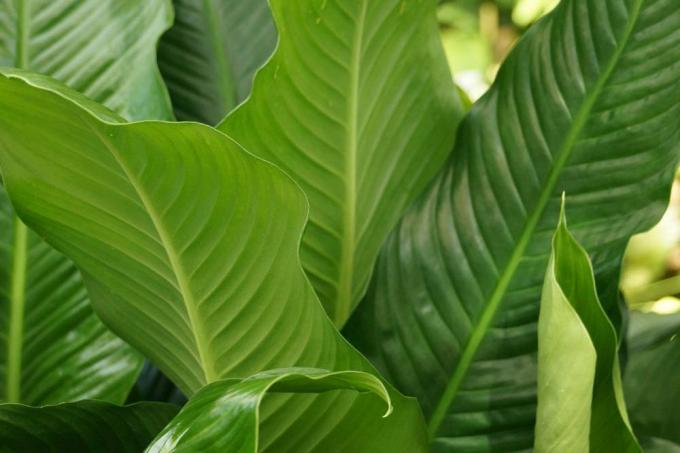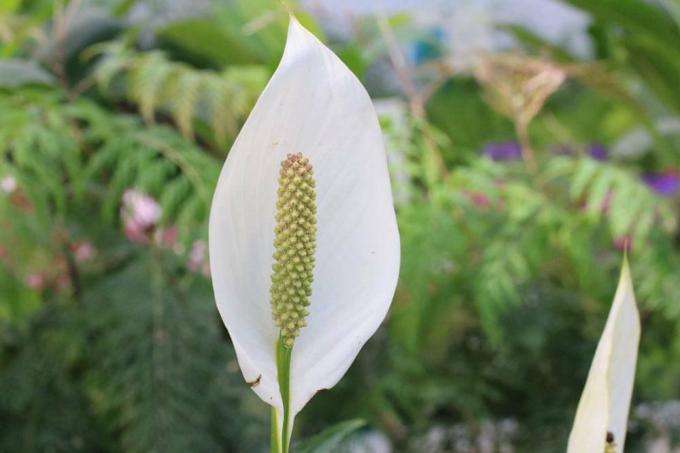
table of contents
- Toxins
- Oxalic acid
- Sharp substances
- Risks
- For children
- measures
- For animals
- measures
Behind the single leaf (Spathiphyllum) hides a decorative, easy-care houseplant, the leaves of which shine in a rich green all year round. The plant genus includes about 50 different species and is also known under the name "leaf flag". The Spathiphyllum floribundum, which in turn comes in many different cultivated forms, is kept as a houseplant. The plant blooms about twice a year, mostly in a brilliant white, a delicate yellow or a noble green. But be careful - the single leaf belongs to the arum family, is poisonous and contains toxic oxalic acid in addition to irritating hot substances.
Toxins
The single sheet - toxic to humans?
Like all arum plants, the leaf plume also contains toxic oxalic acid. The plant also contains certain pungent substances that can irritate both the skin and the mucous membranes. The plant can be toxic to humans as well as animals. This applies not only to consumption, but also to contact through the skin.
Oxalic acid
Basically, oxalic acid is a harmless plant substance, provided it is not consumed in excess. Even rhubarb, Spinach, sorrel and other food crops contain oxalic acid, but only in small amounts. Due to the diet, the body always contains some oxalic acid. Only larger amounts of oxalic acid and its soluble salts can lead to poisoning. The reason - in excess, the acid binds calcium ions and thus has a calcium-removing effect. Furthermore, oxalic acid has a corrosive effect and forms poorly soluble calcium oxalate. Calcium withdrawal can lead to severe cardiovascular problems and kidney failure. The single leaf contains a relatively high amount of oxalic acid, which is why consumption is strongly discouraged. As a result, an overdose of oxalic acid can lead to kidney problems and hyperoxaluria as the oxalates are excreted in the urine.
Tip: In the case of oxalic acid poisoning, a magnesium solution can be used to counteract this, as this can compensate for the imbalance in minerals in the short term. Magnesium tablets can also help quickly, but if in doubt, a doctor should always be consulted.

Sharp substances
The toxic effect of the single leaf cannot be attributed solely to the oxalic acid it contains. Accidental ingestion of a leaf or any other part of a plant would not be enough to cause serious poisoning. The hot substances contained in the sap are more dangerous. If you come into external contact with the sap, this can lead to skin irritation and inflammation. Eating the plant carries an even greater risk. If parts of the plant are eaten, the mucous membranes swell. The stomach and intestines can also be affected, because the hot substances irritate all mucous membranes and can cause severe cramps.
Risks
What are the risks for children?
For children
The Spathiphyllum has no place in the nursery. Small children in particular could consume parts of the plant, but even purely external contact carries certain risks. The following symptoms suggest Spathiphyllum poisoning or reaction.
- Burning, itching and inflammation (with external skin contact with the sap)
- Kidney pain
- Gastrointestinal discomfort, cramps and diarrhea
- swollen mucous membranes
- profuse salivation
- Vomit
Quite a few children are sensitive to allergic reactions to the hot substances contained in the sap, which is why the plant should always be kept in an alternative place that is difficult to access for small children should. Older children, on the other hand, are best protected by informing them beforehand about the toxicity of the plant. If skin contact does occur, it usually leads to burning sensation and irritation. While this is painful, it usually does not cause serious harm.

measures
If, on the other hand, your child has consumed parts of the sheet, you should consult a doctor as a precautionary measure. In an emergency, do not force the child to vomit, give them enough water and contact a doctor as soon as possible. A very high dose in particular can lead to serious symptoms such as kidney damage or severe gastrointestinal bleeding.
Note: Not sure which plants are suitable for households with children and pets and don't want to take any chances? You can find valuable information about the leaf flag and many other poisonous plants at the information center against poisoning (gizbonn.de).
For animals
What are the risks for animals?
The popular ornamental plant has long been poisonous not only for humans, but also for many pets. Dogs, cats, rodents and birds are particularly sensitive. Possible poisoning shows symptoms such as difficulty swallowing, diarrhea, vomiting, cramps and salivation. Forego the sheet of paper if you own pets or place it in a place that will be difficult to get to. A hanging basket hanging from the ceiling is ideal.
measures
If you suspect that one of your pets has nibbled on the plant, you should see a veterinarian immediately. Of course, this is particularly true if there are already visible abnormalities or complaints (e.g. apathy, abnormal sounds, excessive salivation or inability to move).
Tip: In particular, free-flying birds, such as budgies, should be specifically protected. If you have birds, be sure to place the plant in another room or cover it with an appropriate device so that contact can be ruled out.
Sources:
https://www.botanikus.de/Botanik3/Ordnung/Einblatt/einblatt.html
